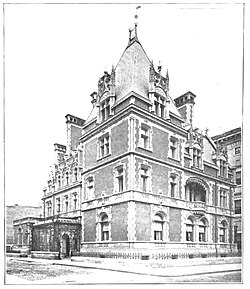| Elbridge Gerry Mansion | |
|---|---|
 The Elbridge Gerry Mansion in 1895, when newly built. | |
|
| |
| General information | |
| Architectural style | French Renaissance |
| Location | Manhattan, New York City |
| Completed | 1895 |
| Opened | 1897 |
| Demolished | 1929 |
| Design and construction | |
| Architect(s) | Richard Morris Hunt |
The Elbridge T. Gerry Mansion was a lavish mansion built in 1895 and located at 2 East 61st Street, at the intersection of Fifth Avenue, in the Upper East Side of Manhattan, New York City. It was built for Commodore Elbridge Thomas Gerry, a grandson of statesman Elbridge Gerry.
History
Elbridge Thomas Gerry (1837–1927) engaged architect Richard Morris Hunt to design an urban reinterpretation of a French Renaissance chateau, specifically requiring Hunt to provide space for his collection of 30,000 law books. [1]
Plans for the house were formally announced in The New York Times on May 15, 1892. [2] Construction began by 1895, and after a reported $3,000,000 in construction costs, the residence was opened officially in 1897. [3] The entrance of the structure, via an iron porte-cochère, [3] was based on the Louis XIII wing of the Château de Blois. [4]
The Gerry mansion became a center of cultivated and fashionable life, even as it came to be surrounded by skyscrapers. [5] Gerry owned sculptural spandrel figures Night and Day by Isidore Konti. [6] In his home, he displayed his extensive international art collection, which included such works as Jean-Léon Gérôme's "Plaza de Toros," a Jean-Jacques Henner bust portrait, Mihály Munkácsy's "Lac Chambre du Nourrisson" from 1884, Adolph Tidemand's "Sunday Morning in Norway," James Edward Freeman's "The Cave of Gasparoni" and "Study of a Young Girl," Jehan Georges Vibert's "The Cardinal's Nephew," Adolf Schreyer's "The Advance Guard," Achillo Guerra's "Absolution of Beatrice Cenci," Jean-Joseph Benjamin-Constant's "Venice: The Return of the Envoy," John Henry Dolph's "A Happy Family," Blackman's "Italian Kitchen," Edwin Lord Weeks' "Woodcarver's Shop: Delhi," Paul Jean Clays's "Port of Ostend," Mauritz de Haas' "Moonrise and Sunset," and Salvator Rosa's "The Revolt of the Tribe". [7] He also owned works by Italian painter Camillo Gioja Barbera, Belgian painter Cornelius Van Leemputten, Polish painter Alfred Kowalski, Austro-French painter Rudolf Ernst, French painter Claude Joseph Vernet, Norwegian painter Vincent Stoltenberg Lerche, and Dutch painter Jan de Baen. [8]
Demolition
Gerry's mansion survived for just 32 years. [9] His executors sold the house after his death in 1927, and in 1929 it was demolished to make way for The Pierre hotel. [3]
See also
- Elbridge Gerry House, Marblehead, Massachusetts, birthplace of statesman Elbridge Gerry
References
- ^ Robinson, Grace (November 1, 1925). "NEWS OF NEW YORK SOCIETY | Social Register at Gerry Wedding". Chicago Tribune. Retrieved 11 September 2016.
- ^ "Mr. E. T. Gerry's New Mansion". The New York Times. 15 May 1892. Retrieved 19 July 2023.
- ^ a b c Tom Miller (June 11, 2012). "The Lost Elbridge T. Gerry Mansion -- Fifth Avenue and 61st Street".
- ^ Stern, Robert A. M.; Gilmartin, Gregory; Massengale, John Montague (1983). New York 1900: Metropolitan Architecture and Urbanism, 1890–1915. New York: Rizzoli. p. 316. ISBN 0-8478-0511-5. OCLC 9829395.
- ^ "COMMODORE ELBRIDGE T. GERRY | A SKETCH". The Tammany Times. Tammany Publishing Company. 1 January 1896. Retrieved 11 September 2016.
- ^ Madigan, Mary Jean Smith, The Sculpture of Isidore Konti: 1862-1938, Hudson River Museum, 1975, number 10
- ^ "PAINTINGS TO BE SOLD FOR GERRY ESTATE; Additions From the Collections of Mrs. J.B. Bloomingdale and Others Are Also Offered" (PDF). The New York Times. 29 January 1928. Retrieved 4 June 2019.
- ^ Important paintings by Mauve, Sargent, Diaz, Hassam, Blakelock, Maufra, Inness, Davies, Twachtman, Hoppner, Lely, Bronzino and artists of like distinction; Oil paintings by representative European and American XVIII and XIX masters. New York: American Art Association. 1928. pp. 20, 28, 30, 42, 46, 54–56, 62, 64–65, 75, 110, 114–119. Retrieved 4 June 2019.
- ^ Wos, Andy (January 2014). "GILDED AGE IN ANDES: HISTORY OF THE GERRY ESTATE — January 2014 | Andes Gazette". Andes Gazette. Retrieved 17 January 2018.